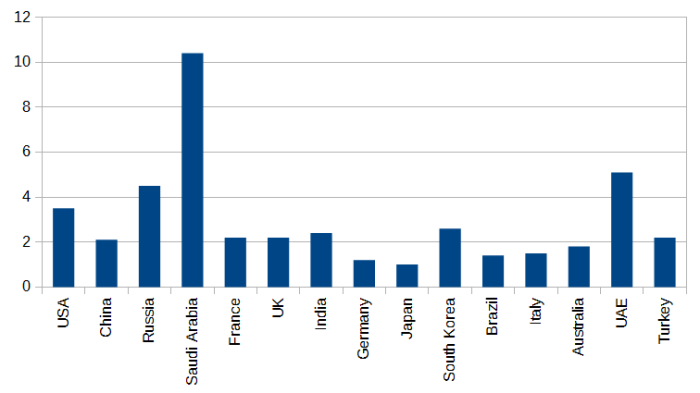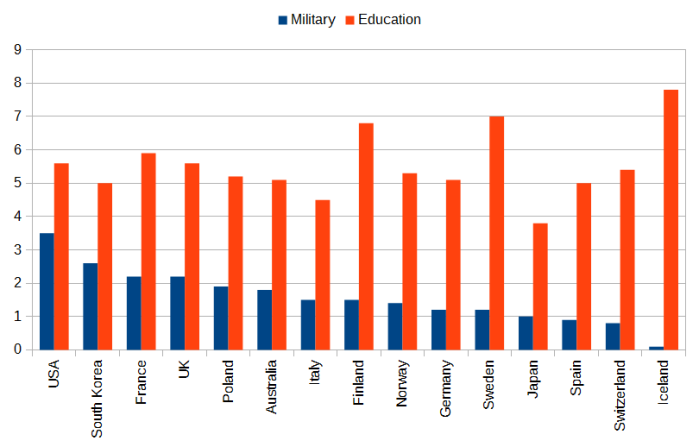JDN 2457927 EDT 20:20.
This week on Facebook I ran into a couple of memes about the defense budget that I thought were worth addressing. While the core message that the United States spends too much on the military is sound, these particular memes are so massively misleading that I think it would be irresponsible to let them go unanswered.
First of all, this graph is outdated; it appears to be from about five years ago. If you use nominal figures for just direct military spending, the budget has been cut from just under $700 billion (what this figure looks like) in 2010 to only about $600 billion today. If you include verterans’ benefits, again nominally, we haven’t been below $700 billion since 2007; today we are now above $800 billion. I think the most meaningful measure is actually military spending as percent of GDP, on which we’ve cut military spending from its peak of 4.7% of GDP in 2010 to 3.5% of GDP today.
It’s also a terrible way to draw a graph; using images instead of bars may be visually appealing, but it undermines the most important aspect of a bar graph, which is that you can easily visually compare relative magnitudes.
But the most important reason why this graph is misleading is that it uses only the so-called “discretionary budget”, which includes almost all military spending but only a small fraction of spending on healthcare and social services. This creates a wildly inflated sense of how much we spend on the military relatively to other priorities.
In particular, we’re excluding Medicare and Social Security, which are on the “mandatory budget”; each of these alone is comparable to total military spending. Here’s a very nice table of all US government spending broken down by category.
Let’s just look at federal spending for now. Including veterans’ benefits, we currently spend $814 billion per year on defense. On Social Security, we spend $959 billion. On healthcare, we spend $1,018 billion per year, of which $536 billion is Medicare.
We also spend $376 billion on social welfare programs and unemployment, along with $149 billion on education, $229 billion servicing the national debt, and $214 billion on everything else (such as police, transportation, and administration).
I’ve made you a graph that accurately reflects these relative quantities:
As you can see, the military is one of our major budget items, but the largest categories are actually pensions (i.e. Social Security) and healthcare (i.e. Medicare and Medicaid).
Given the right year and properly adjusted bars on the graph, the meme may strictly be accurate about the discretionary budget, but it gives an extremely distorted sense of our overall government spending.
The next meme is even worse:
Again the figures aren’t strictly wrong if you use the right year, but we’re only looking at the federal discretionary budget. Since basically all military spending is federal and discretionary, but most education spending is mandatory and done at the state and local level, this is an even more misleading picture.
Total annual US military spending (including veteran benefits) is about $815 billion.
Total US education spending (at all levels) is about $922 billion.
Here’s an accurate graph of total US government spending at all levels:
That is, we spend more on education than we do on the military, and dramatically more on healthcare.
However, the United States clearly does spend far too much on the military and probably too little on education; the proper comparison to make is to other countries.
Most other First World Countries spend dramatically more on education than they do on the military.
France, for example, spends about $160 billion per year on education, but only about $53 billion per year on the military—and France is actually a relatively militaristic country, with the 6th-highest total military spending in the world.
Germany spends about $172 billion per year on education, but only about about $44 billion on the military.
In absolute figures, the United States overwhelms all other countries in the world—we spend as much as at least the next 10 combined.
Using figures from the Stockholm International Peace Research Institute (SIPRI), the US spends $610 billion of the world’s total $1,776 billion, meaning that over a third of the world’s military spending is by the United States.
This is a graph of the top 15 largest military budgets in the world.
One of these things is not like the other ones…
It probably makes the most sense to compare military spending as a portion of GDP, which makes the US no longer an outlier worldwide, but still very high by First World standards:
If we do want to compare military spending to other forms of spending, I think we should do that in international perspective as well. Here is a graph of education spending versus military spending as a portion of GDP, in several First World countries (military from SIPRI and the CIA, and education from the UNDP):
Our education spending is about average (though somehow we do it so inefficiently that we don’t provide college for free, unlike Germany, France, Finland, Sweden, or Norway), but our military spending is by far the highest.
How about a meme about that?







Is there a takeaway here for those who are working with military budgets? Or are you saying that a clever choice of data can support almost any argument?
LikeLike
Well, the takeaway as far as the military budget is that we do in fact spend too much, but the narrative that we spend huge amounts on the military and almost nothing on public services is false. We spend a lot on public services, as well we should.
I don’t like people who agree with me using bad data. I think it makes me even more angry that people I disagree with using bad data, because it feels more like a betrayal; ultimately the deception gets exposed and it hurts our side. Any true belief should be supportable by good arguments and good data. If you can’t argue for your belief without misrepresenting data, then maybe your belief is wrong!
LikeLike
[…] war—by some estimates we have been at war 93% of the time since our founding as a nation, and it is a well-documented fact that we have by far the highest military spending in the world. Why is it that so many Americans see diplomacy as foolish, see compromise as […]
LikeLike
[…] course I’ve already talked about our enormous military budget; but then Tennessee had to make their official state rifle a 50-caliber weapon capable of […]
LikeLike
[…] in national security above our already overwhelming conventional military. While we’re at it, we would downsize that military in order to save enough money to end world […]
LikeLike
[…] or the fact that federal aid and earmarks are tiny portions of the budget. A couple years ago I had to debunk a meme that was claiming that we spend a vastly larger portion of the budget on defe… than we actually […]
LikeLike